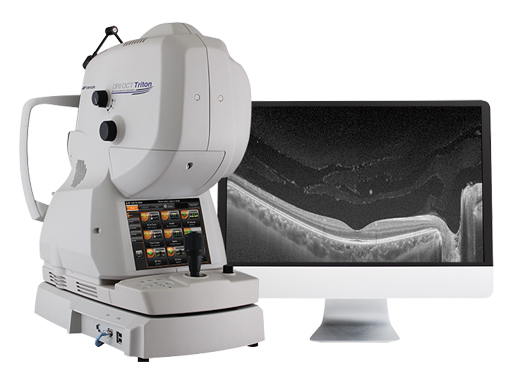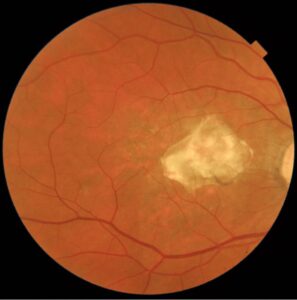OCT Scan
Swept Source DRI Topcon Triton® Optical Coherence Tomography OCT
At Smile Laser Eye Centre Multan we are proud to have the world’s only most advanced vitreo-retinal diagnostics tool Swept-Source OCT available for the people of Pakistan. Handful number of Swept-Source Optical Coherence Tomography Scan devices are available in Pakistan at the moment. It is unique that no Swept-Source OCT device is present anywhere else in Lower Punjab. 
An optical coherence tomography scan (OCT scan) helps us to view the health of your eyes in greater detail. It allows us to see what is going on beneath the surface of the eye.
Swept-Source OCT technology is the world’s best technology with fastest scanning time. It has infra-red light for superior visualization compared to standard OCT scanners. Infra-red light used is invisible, making the scan more comfortable and less distracting for the patient.
This new and advanced imaging technology allows better identification of the outer layer of the vitreous (the clear gel that fills the space between the lens and the retina), the interface between the vitreous and the retina and a greater number of layers within the retina itself as well as under the retina, all with the same sensitivity. This technology allows the visualization of the intraocular structures in 3D, which makes it easier for the patient to understand the internal architecture of the eye.
SS-OCT can take detailed high-quality images which are less affected by eye-movements and cataract formation compared to standard scanners.
This test can confirm Posterior Vitreous Detachment (PVD) and is an important diagnostic test for patients with reduced or distorted central vision, for example in the presence of an Epiretinal Membrane (ERM) or Macular Hole.
Swept-Source DRI Topcon Triton® OCT & OCTA also allows the assessment of retinal blood flow and the diagnosis of abnormal blood vessels in the macula in a non-invasive manner. MCULA is the central part of the retina. This is an important diagnostic test for Diabetic Maculopathy and Retinopathy and patients with AMD.
This technology aids early detection, management & monitoring of vitreo-retinal conditions.
Why do I need an OCT scan?
OCT scans are recommended for people aged 25 or over, who want to know more about their eye health, or those who have diabetes, glaucoma, or have family history of eye disease.

So the next time you visit the doctor, he can compare your images from your last visit as well as comparing measurements to averages and might spot even the tiniest change in the eye’s structures. This could help indicate the early signs of an eye health condition like glaucoma, diabetic retinopathy and macular degeneration before you have any symptoms. Even if your vision and eye health are perfectly fine, it is still recommend to have an OCT scan every year. It’s really useful for your doctor to have a baseline image on file, so they can monitor any changes over time. It’s the same as when we take an image of the back of your eye with digital retinal photography.
This means that conditions like these can be managed before they get worse and can help prevent potential sight loss. That’s a pretty good result for just a quick scan.
What is an OCT scan used for and what conditions can it help to detect?
OCT scanning is great at confirming that your eyes are healthy and can be repeated over time for comparison. This makes it particularly useful for detecting potentially sight threatening conditions that generally don’t have any symptoms until they start to have an impact on your vision.

Many of these conditions form at the very back of the eye, and OCT allows your doctor to identify subtle changes over time, such as changes in the vitreous (the jelly-like substance that fills the eye), retina (the light-sensitive layer at the back of the eye), macula (an area at the centre of the retina responsible for our central vision) and the optic nerve (transmits light impulses to the brain to produce the images we see).
These include:
Glaucoma
Diabetic retinopathy
Detached retina
Age-related macular degeneration
Macular hole
In fact, an OCT scan can help to detect glaucoma up to four years earlier than traditional methods.
I am diabetic do I need an OCT scan?
Yes- Diabetic checks involve a fundus picture from OCT – this is an image of the surface of the back of the eye (the retina) also known as digital retinal photography. OCT images also allow us to look at the many layers beneath the surface of the retina, which helps us to spot changes to eye health earlier than just looking at the surface.
OCT scans also help in the detection of a range of other eye problems, not just those that are linked to diabetes.